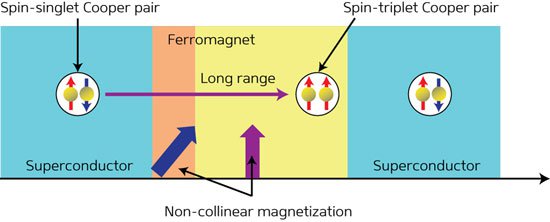Researchers from Korea's RIKEN Center proposed a device that instead of moving electrons is able to transport information using electron spin over long distances. The idea is to sandwich two adjacent thin magnetic films between superconducting layers.

The researchers explain that in conventional superconductors, the electrons are bound together in pairs formed by antiparallel electron spins (this is called a spin-singlet Cooper pair). However, with a ferromagnetic layer nearby, the spin of the two electrons in such a Cooper pair will align itself in the same direction as the magnetic field. So you can move the spin-triplter Cooper pairs from the superconductor into the ferromagnetic layer, where they are very stable and long-lived. The researchers have shown mathematically that within the ferromagnetic layer, those pairs are able to carry spin currents over extended distances of several tens to hundreds of nanometers, and possibly even more (depends on the purity of the magnetic material). In this movement, no hear will be generated.